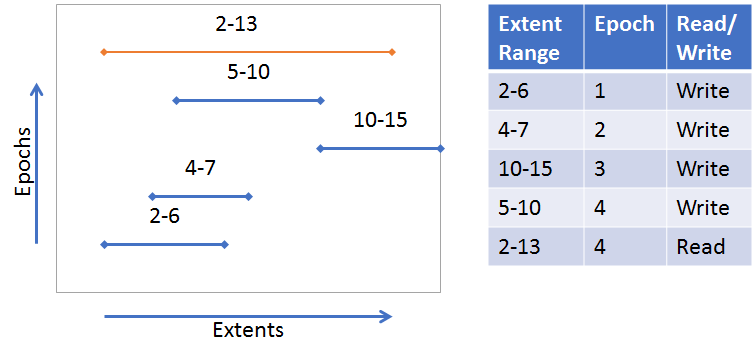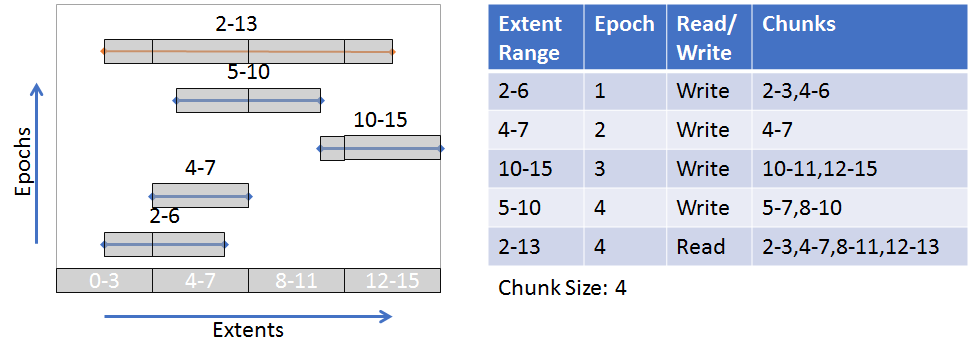Data Integrity¶
DAOS uses checksums internally to discover silent data corruption. While each component in a system (network layer, storage devices) may offer protection against silent data corruption, DAOS provides end-to-end data integrity to better protect user data. If silent data corruption is detected, DAOS will attempt to recover the corrupted data using data redundancy mechanisms (Replication or Erasure Code).
End-to-end Data Integrity¶
In simple terms, end-to-end means that the DAOS Client library will calculate a
checksum for data that is being sent to the DAOS Server. The DAOS Server will
store the checksum and return it upon data retrieval. Then the client verifies
the data by calculating a new checksum and comparing to the checksum received
from the server. There are variations on this approach depending on the type of
data being protected, but the following diagram shows the basic checksum flow.

Configuring¶
Data integrity is configured for each container. See Storage Model for more information about how data is organized in DAOS. See the Data Integrity in the Container User Guide for details on how to setup a container with data integrity.
Keys and Value Objects¶
Because DAOS is a key/value store, the data for both keys and values is protected, however, the approach is slightly different. For the two different value types, single and array, the approach is also slightly different.
Keys¶
On an update and fetch, the client calculates a checksum for the data used as the distribution and attribute keys and will send it to the server within the RPC. The server verifies the keys with the checksum. While enumerating keys, the server will calculate checksums for the keys and pack within the RPC message to the client. The client will verify the keys received.
Note
Checksums for keys are not stored on the server. A hash of the key is calculated and used to index the key in the server tree of the keys (see VOS Key Array Stores). It is also expected that keys are stored only in Storage Class Memory which has reliable data integrity protection.
Values¶
On an update, the client will calculate a checksum for the data of the value and will send it to the server within the RPC. If "server verify" is enabled, the server will calculate a new checksum for the value and compare with the checksum received from the client to verify the integrity of the value. If the checksums don't match, then data corruption has occurred and an error is returned to the client indicating that the client should try the update again. Whether "server verify" is enabled or not, the server will store the checksum. See VOS for more info about checksum management and storage in VOS.
On a fetch, the server will return the stored checksum to the client with the values fetched so the client can verify the values received. If the checksums don't match, then the client will fetch from another replica if available in an attempt to get uncorrupted data.
There are some slight variations to this approach for the two different types of values. The following diagram illustrates a basic example. (See Storage Model for more details about the single value and array value types)

Single Value¶
A Single Value is an atomic value, meaning that writes to a single value will update the entire value and reads retrieve the entire value. Other DAOS features such as Erasure Codes might split a Single Value into multiple shards to be distributed among multiple storage nodes. Either the whole Single Value (if going to a single node) or each shard (if distributed) will have a checksum calculated, sent to the server, and stored on the server.
Note that it is possible for a single value, or shard of a single value, to be smaller than the checksum derived from it. It is advised that if an application needs many small single values to use an Array Type instead.
Array Values¶
Unlike Single Values, Array Values can be updated and fetched at any part of an array. In addition, updates to an array are versioned, so a fetch can include parts from multiple versions of the array. Each of these versioned parts of an array are called extents. The following diagrams illustrate a couple examples (also see VOS Key Array Stores for more information):
A single extent update (blue line) from index 2-13. A fetched extent (orange line) from index 2-6. The fetch is only part of the original extent written.

Many extent updates and different epochs. A fetch from index 2-13 requires parts from each extent.

The nature of the array type requires that a more sophisticated approach to creating checksums is used. DAOS uses a "chunking" approach where each extent will be broken up into "chunks" with a predetermined "chunk size." Checksums will be derived from these chunks. Chunks are aligned with an absolute offset (starting at 0), not an I/O offset. The following diagram illustrates a chunk size configured to be 4 (units is arbitrary in this example). Though not all chunks have a full size of 4, an absolute offset alignment is maintained. The gray boxes around the extents represent the chunks.

( See Object Layer for more details about the checksum process on object update and fetch)
Checksum calculations¶
The actual checksum calculations are done by the isa-l and isa-l_crypto libraries. However, these libraries are abstracted away from much of DAOS and a common checksum library is used with appropriate adapters to the actual isa-l implementations. common checksum library
Performance Impact¶
Calculating checksums can be CPU intensive and will impact performance. To mitigate performance impact, checksum types with hardware acceleration should be chosen. For example, CRC32C is supported by recent Intel CPUs, and many are accelerated via SIMD.
Quality¶
Unit and functional testing is performed at many layers.
| Test executable | What's tested | Key test files |
|---|---|---|
| common_test | daos_csummer, utility functions to help with chunk alignment | src/common/tests/checksum_tests.c |
| vos_test | vos_obj_update/fetch apis with checksum params to ensure updating and fetching checksums | src/vos/tests/vts_checksum.c |
| srv_checksum_tests | Server side logic for adding fetched checksums to an array request. Checksums are appropriately copied or created depending on extent layout. | src/object/tests/srv_checksum_tests.c |
| daos_test | daos_obj_update/fetch with checksums enabled. The -z flag can be used for specific checksum tests. Also --csum_type flag can be used to enable checksums with any of the other daos_tests | src/tests/suite/daos_checksum.c |
Running Tests¶
With daos_server not running
./commont_test
./vos_test -z
./srv_checksum_tests
With daos_server running
export DAOS_CSUM_TEST_ALL_TYPE=1
./daos_server -z
./daos_server -i --csum_type crc64